Easy In-Room Activities for Stroke Patients

Enter the importance of in-room activities that can be practiced outside traditional therapy time. In this article, we will discuss easy functional activities and exercises for the upper body that you can practice in an environment as simple as a hospital room.

Functional Tasks
According to Teasell in 2020, task-specific training provides cortical reorganization (changes to the brain) that are longer-lasting than traditional stroke rehabilitation. Teasell states that “repetition, in the absence of skilled motor learning, is often not enough for cortical relearning to occur.”
That’s a lot to unpack. Let’s rephrase. This research suggests that a therapy program is incomplete when it focuses only on upper body movement repetitions alone. It is important to integrate functional tasks, like reaching for an object, for example, into stroke rehabilitation programs.
One of the ten principles of neuroplasticity is “use it or lose it”. This is especially true in neurological rehabilitation. The importance of using the affected limb as much as possible to assist with functional daily tasks cannot be understated. Performing movement repetitions with the affected limb helps to re-educate the brain following a stroke, as evidenced by Winstein.
One thing that may be beneficial for patients is an activities practice log for their room.
Functional Activities For the Room or Home
- Practice buttoning or using a zipper. Using the involved hand to stabilize the clothing item or manage the button/zipper.
- Practice tying shoes or velcroing shoes.
- Practice putting on earrings or jewelry.
- Practice washing a table and using a spray bottle in the room.
- Practice putting on a hat with one hand and then with both hands.
- Practice turning pages in a book, stabilizing the book with the unaffected hand.
- Practice lifting an empty glass up and down from a surface. When this gets easier, fill the glass progressively with water and continue practicing.
- With a spoon, practice bringing your hand to your mouth.
- Practice opening boxes or stabilizing objects in a kitchen.
- Practicing folding clothing or socks.
In-Hand Manipulation and Fine Motor Skills
The activities below work on fine motor skills such as in-hand manipulation, fine motor shift, grasping, pinching and finger isolation skills.
- Beginning with one small marble in the center of the palm, roll it slowly out to the end of the fingertips and put it on the table (without the assistance of the other hand). Then pick it up with the thumb and index finger and slowly roll it back into the palm. *** if a small marble is too challenging for this activity, use a large marble or a quarter.
- Practice writing with the affected hand. If grip is difficult ask your occupational therapist for a recommendation for an adaptive pencil grip or use a larger writing utensil.
- Practice fine motor coordination with a pen or pencil by flipping and repositioning the pencil around with the fingers alone.
- Practice picking up a block. If this is too hard, practice picking up a larger object like a stress ball. If picking up a block is easy, try picking up a smaller object like a bead, or even a penny.
- Practice bringing each fingertip to meet the tip of the thumb in an “O” shape.
- Practice picking up small items on a desk (like erasers) by isolating the thumb and index finger.
- Practice grasping and releasing a small object in your palm.
Mental Imagery
Mental imagery is the act of mentally rehearsing a task before completing it. In a Cochrane review, mental practice combined with physical practice appeared to be more beneficial. Clinicians may suggest using written instructions or pictures as a part of mental practice.
Easy Mental Imagery Activities
- Mentally practice and visualize the steps of brushing your hair, then pick up the brush, practice grasping the handle and raising your arm to brush your hair. If you cannot reach your hair or your movement isn’t smooth, don’t be discouraged. it’s the initiation of the movement that’s the most important. Quality will improve with practice and time.
- Mentally practice functional reach to a shelf or table. Break down the steps, visualizing each one in detail, then attempt to perform them physically.
- Break down the task of tooth brushing into small steps. After mentally rehearsing, physically attempt the task with the affected hand.
Integrating Homework Activities Into Rehabilitation Robotics
The use or rehabilitation robotics is an evidence-based treatment approach that has been shown to improve motor performance. Although there is evidence supporting that these devices improve motor performance, it is important to integrate functional practice into a robotics program. Outside of robot-assisted therapy sessions patients can log practice with functional reach and the same movements they are performing in therapy.
In summary, time in the hospital room outside of therapy is not time that has to be wasted. The integration of simple in-room tasks with our patients may be beneficial in maximizing participation in task-oriented training and motor repetitions needed to achieve neuroplastic changes in the brain.
** Exercises should be performed under the supervision of a licensed therapist and by the order of a treating physician. These exercises are not intended to be medical advice.**
References
- Teasell, et al. (2020). Hemiplegic Upper Extremity Rehabilitation. EBRSR.com. Retrieved February 3, 2022, from http://www.ebrsr.com/sites/default/files/EBRSR%20Handbook%20Chapter%204_Upper%20Extremity%20Post%20Stroke_ML.pdf
- Kleim JA, Jones TA. Principles of experience-dependent neural plasticity: implications for rehabilitation after brain damage. J Speech Lang Hear Res. 2008 Feb;51(1):S225-39. doi: 10.1044/1092-4388(2008/018). PMID: 18230848.
-
Winstein, C., Schweighofer, N., Martinez, C., Kim, S., & Kim, B. (2019). Dosage Matters A Phase IIb Randomized Controlled Trial of Motor Therapy in the Chronic Phase After Stroke. Stroke, 50(7), 1831–1837. https://doi.org/https://doi.org/10.1161/STROKEAHA.118.023603
- Barclay RE, Stevenson TJ, Poluha W, Semenko B, Schubert J. Mental practice for treating upper extremity deficits in individuals with hemiparesis after stroke. Cochrane Database of Systematic Reviews 2020, Issue 5. Art. No.: CD005950. DOI: 10.1002/14651858.CD005950.pub5.
- Masiero S, Celia A, Rosati G, Armani M. Robotic-assisted rehabilitation of the upper limb after acute stroke. Arch Phys Med Rehabil. 2007 Feb;88(2):142-9. doi: 10.1016/j.apmr.2006.10.032. PMID: 17270510.